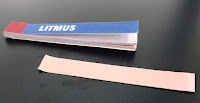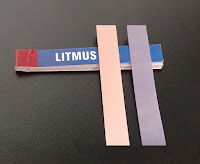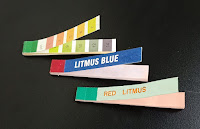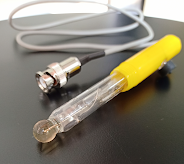Indicators are a type of chemical that can change color as pH levels change. Several indicators are used in chemistry, including pH paper, universal indicator, and litmus paper (blue or red). These are the rapid and most simple methods for determining pH compared to pH meter whether a sample is liquid or gaseous.
The pH (potential of Hydrogen) value is used to express the concentration of hydrogen in a solution. The pH scale has a range of 0 to 14 and corresponds to the negative logarithm of hydrogen ion concentration.
| Table of Contents: |
An acid is a substance that donates hydrogen ions, therefore when there are more hydrogen ions in a solution than hydroxide ions, it is acidic.
A base is a substance that accepts hydrogen ions, therefore when there are more hydroxide ions in a solution than hydrogen ions, it is alkaline.
What is litmus paper in chemistry?
Litmus paper is a type of indicator that comes in the form of a paper strip and is used to determine whether a sample solution is acidic or basic. It is made by mixing water-soluble dyes that are absorbed into the filter paper strips. It is impregnated with lichens, which gives it the capacity to change color when exposed to an acid or base.
“Litmus paper is defined as; it is a strip of paper impregnated with litmus, which is used as a chemical indicator”
Litmus paper is widely used in science classes and practicals, and because of its wide recognition, it has also become a cultural reference in our society.
History of litmus paper:
The word "litmus" is derived from a Norse word that means "dye" or "color." Around 1300 AD, the Spanish physician Arnaldus de Villa Nova first used litmus paper. Originally, litmus was a blue dye produced by a variety of lichen species of the Netherlands. However, litmus can have 10 to 15 different dyes.
What is litmus paper made of?
As the name suggests, litmus paper is primarily composed of paper. Wood cellulose, lichens, and adjunct compounds are the basic raw materials used to formulate litmus paper.
The paper used to compose litmus paper must be free of contaminants, as that can affect the pH of the sample being tested. Litmus paper, like most other types of paper, is made from the cellulose of wood.
Manufacturing process of litmus paper:
- Before the paper making process, wood is treated with solvents to remove resinous substances and lignin. Litmus paper provides many features with manufacturing paper production.
- In this method, the wood pulp is converted into paper, which is then infused with the lichen solution, dried, and packed.
- Many industries in the market manufacture litmus paper and pH paper, with a different quality that you can buy at different prices.
Types of litmus paper:
Red and blue are two types of litmus paper. Blue litmus paper is used to check for acidity (acidic pH) of the solution; while red litmus paper is used to check for basicity (basic pH) of the solution
Red litmus paper:
 Red litmus paper consists of a weak-diprotic acid which purpose is to determine the basicity. When it is exposed to the basic or alkaline substance, a reaction happens between hydrogen ions and a base that produces a color change which changes to blue.
Red litmus paper consists of a weak-diprotic acid which purpose is to determine the basicity. When it is exposed to the basic or alkaline substance, a reaction happens between hydrogen ions and a base that produces a color change which changes to blue. However, if it comes into contact with an acidic or neutral solution, it will remain red.
Blue litmus paper:
 Blue litmus paper already consists of a blue conjugate base and is used to determine the acidity. When it is exposed to the acidic substance, it reacts with acid and that produces a color change which changes to red.
Blue litmus paper already consists of a blue conjugate base and is used to determine the acidity. When it is exposed to the acidic substance, it reacts with acid and that produces a color change which changes to red. However, if it comes into contact with a basic or neutral solution, it will remain blue.
How litmus paper works (Mechanism):
- Red litmus contains a weak diprotic acid. The hydrogen ions react with the added base when it is exposed to a basic compound. The conjugate base formed from litmus acid is blue; therefore wet red litmus paper turns blue color in alkaline solution.
- On the other hand, blue litmus paper already contains a blue conjugate base. When it comes into contact with an acid, it becomes red.
- In addition, blue litmus paper can indicate an acid that has a pH level of about 04 to 05 or less. Similarly, red litmus paper may indicate a base that has a pH level greater than 08. However, if a sample solution has a pH of 05 to 08; it indicates a minute change in color on paper.
How to perform litmus test:
- The litmus test is performed by placing a drop of liquid sample on a strip of paper or immersing a piece of litmus paper in a sample. Ideally, it is not recommended to immerse the litmus paper in the entire container of a sample solution, as the dye can potentially contaminate the samples.
- Litmus paper can be moistened with distilled water to change the color of the gaseous sample. The gases sample changes the color of the entire litmus strip when the entire surface is exposed.
- Litmus paper that has changed color from red to blue can be used again as blue litmus paper. Litmus paper that has changed color from blue to red can be used again as red litmus paper.
The table shows how the color of litmus paper changes in different solutions.
| Condition | Red litmus | Blue litmus |
|---|---|---|
| In acidic solution | Remains Red | Turns red |
| In neutral solution | Remains red | Remains blue |
| In alkaline solution | Turns blue | Remains blue |
Advantages of litmus paper:
- Litmus testing is a simple and cost-effective procedure that does not require a trained person or the use of expensive equipment.
- It is a fairly simple acid-base indicator that provides accurate results.
- It quickly determines the nature of the substance compared to other methods of pH determination.
- Litmus paper is used for both liquid and gaseous samples.
Disadvantages of litmus paper:
- Like a pH indicator, pH meter, or pH paper, it does not determine the strength of the sample.
- If it is immersed in the sample solution, it can contaminate them.
- It is a one-time use item that may have issues with the reproducibility of results.
FAQ (Frequently Asked Questions):
What are the use of litmus paper and pH paper?
Litmus paper and pH strips are used in chemistry to determine the acidity or alkalinity of a sample solution. Litmus paper simply states whether a solution is acidic or alkaline, while a pH paper determines the pH value of a solution.
What does it mean when litmus paper is blue?
This means that the pH of the sample is alkaline.
What is the difference between blue and red litmus paper?
The reactivity to different pH values is the major difference between them; blue litmus paper reacts to acidic samples, with red litmus paper reacts to alkaline samples.
How does litmus paper indicate an acid?
Litmus paper is a filter paper that turns red in acidic solution and blue in alkaline solution.
Litmus paper is an example of what?
Litmus paper is an example of an organic indicator; it is a chemical substance that changes color when exposed to acids or bases, for example, Sodium hydroxide (NaOH), and Hydrochloric acid (HCL).
You may also like this




